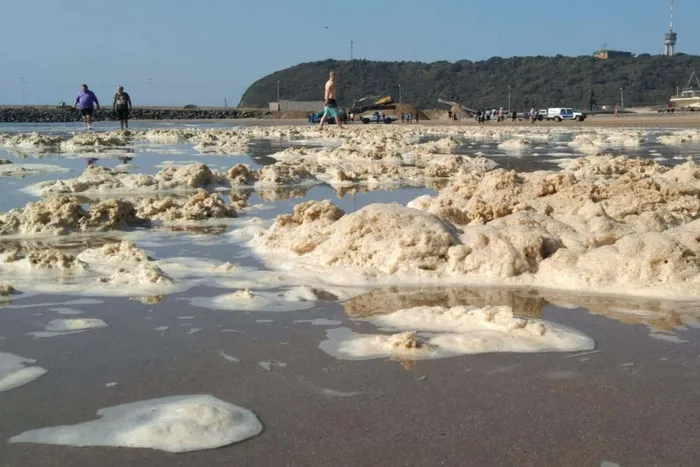eThekwini Municipality is pumping sand on the beachfront

Light brown foam on the beach is sea foam, also known as ocean foam or spume, is actually a very nutritious broth or soup of organic matter. Picture: South African Association for Marine Biological Research
Durban — The eThekwini Municipality has clarified that it is not pumping sewage into uShaka Beach. The municipality also backed up its statement by sharing an article from the South African Association for Marine Biological Research (Saambr) which explains what was happening at the beach.
EThekwini Municipality communications head Lindiwe Khuzwayo said the municipality would like to clarify that the city is currently busy with a sand-pumping operation on the beachfront close to the harbour mouth. It is done annually to ensure that our beaches remain in pristine condition for all beachgoers.
“Social media reports of sewer being pumped onto the beach are malicious, false and ignorant,” Khuzwayo said.
“The sand-pumping scheme creates a recreational beach and pumps approximately 280 000 cubic metres of sand onto the beaches every year. This also acts as a buffer between the beach and infrastructure.
“The harbour breakwaters prevent the natural migration of sand from south to north on our beachfront necessitating the sand pumping operation. If the city did not pump sand, our beaches would erode away with the action of the waves,” Khuzwayo explained.
She said that continuous beach monitoring programmes are in place to provide sediment data on the beaches which guide the sand pumping scheme.
“The darker colour of the sand is because of naturally occurring minerals such as quartz, feldspar, titanium and ilmenite which are black in colour. This should not be confused with oil or a sewage spill,” Khuzwayo said.
She cautioned the public to avoid the area where the sand is being pumped especially towards the water’s edge as the sand is soft and liquified and could act as quicksand.
“The foamy substance in the water is a natural occurrence due to turbulence in the water and is not harmful,” Khuzwayo said.

In July 2021, former Saambr conservation strategist Dr Judy Mann said the light brown foam is sea foam, also known as ocean foam or spume, and is actually a very nutritious broth or soup of organic matter.
Mann said that seawater is composed of lots of different things including water, salts, and organic matter such as bacteria, plankton (tiny plants and animals), broken-down bits of bigger plants and animals, animal poop and much more. Under turbulent conditions created by strong winds and waves – the “soup” can get whipped up into a proteinaceous foam of air bubbles on the surface. This is nature’s way of filtering out organic matter from the water column onto the sea surface and from there, it can wash up onto the beach.
“Although it does not look that great, most sea foam is not harmful to humans. In fact, it is a sign that the ocean is filled with life. Sometimes however, the sea foam can have harmful effects on both humans and the environment, such as when harmful algal blooms (such as red tide) occur and decay near shore, or when the sea foam concentrates man-made pollutants. So, just to be extra sure, it is best not to play in the foam, especially close to industrial outfalls and pipelines.”
WhatsApp your views on this story at 071 485 7995.
Daily News